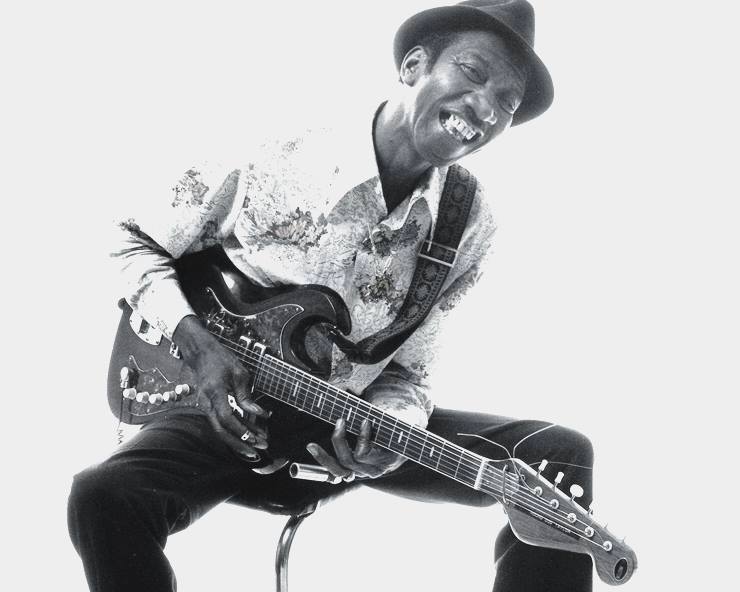Hound Dog Taylor – A Complete Biography
Introduction
Hound Dog Taylor (born Theodore Roosevelt Taylor) was a combustible slide-guitar powerhouse whose raw, joyous Chicago blues helped launch Alligator Records and inspired generations of guitar-driven bands. Famous for playing cheap gear at deafening volume, fronting a bass-less trio (two guitars and drums), and for the six fingers on his fretting hand, Taylor turned simplicity into a signature—what he called “making it sound good.”

Childhood
Taylor was born on April 12, 1915, in Natchez, Mississippi (some sources list 1917), and grew up in the Delta. He first played piano, then—around age twenty—took up the guitar. Accounts of his early years describe sharecropping by day and music at night in juke joints and house parties, a path typical of Delta musicians of his generation. He was also born with polydactyly, having six fingers on each hand—a feature he’d later lean into as a slide player.
Youth
In 1942, after a Ku Klux Klan cross-burning in his yard, Taylor left Mississippi for Chicago. There he hustled for tips on Maxwell Street alongside players like Muddy Waters and Robert Nighthawk, while holding factory jobs and gigging in taverns. Through the 1950s he sharpened a hard, urban slide style under the sway of Elmore James, gradually moving from weekend musician to full-time pro by the late ’50s.
Adulthood
By the 1960s, Taylor’s uncompromising club show—two guitars (Taylor plus second guitarist Brewer Phillips) and drummer Ted Harvey, no bass—had become legend on Chicago’s South and West Sides, including a regular Sunday slot at Florence’s Lounge. When Bruce Iglauer couldn’t convince his employer Delmark Records to record the band, he scraped together his savings, founded Alligator Records, and cut Hound Dog Taylor & the HouseRockers (1971) in two nights. That debut became Alligator’s first release and put Taylor on national tours and festival stages. The band’s setup and Taylor’s overdriven slide—often on a bargain Teisco guitar through a battered Sears amp—defined an ecstatic, high-energy sound critics compared to “electronic gutbucket.”
Taylor’s follow-up Natural Boogie (1974) broadened his palette and, along with the posthumous live set Beware of the Dog! (recorded 1974, issued 1976), cemented his reputation as a ferocious live act. Later archival sets like Genuine Houserocking Music and Release the Hound kept the legend in circulation.
Major compositions
Although steeped in standards by Elmore James and others, Taylor wrote a stack of rough-and-ready originals that became modern bar-band canon. Highlights include:
- “Give Me Back My Wig” (1971) — a swaggering, slide-driven shuffle that later drew covers from George Thorogood and Stevie Ray Vaughan and helped define Taylor’s party-ready persona.
- “She’s Gone” (1971) — biting, minor-key churn with stinging slide phrases.
- “Walking the Ceiling” (1971) — a chugging workout built on interlocking two-guitar rhythms.
- “Taylor’s Rock” (1971) and “55th Street Boogie” (1971) — instrumental showcases for his raw slide attack and the band’s bass-less drive.
- “I Just Can’t Make It” (1971) — a compact statement of his vocal style: direct, urgent, and a little ragged in all the right ways.
- “Sadie” (1974) and “Goodnight Boogie” (1974) — long-form stage pieces from Natural Boogie that balanced grit with momentum.
Death
In mid-1975, after years of smoking and hard touring, Taylor was diagnosed with lung cancer. He died in Chicago on December 17, 1975, aged 60, and was buried in Restvale Cemetery in Alsip, Illinois. Shortly before his death, a notorious personal conflict spilled into the press: during a drunken argument, Taylor shot bandmate Brewer Phillips (who survived); Taylor was charged with attempted murder but succumbed to cancer before any trial.
Conclusion
Hound Dog Taylor didn’t traffic in polish; he specialized in feeling—fast, loud, “have some fun” blues that connected barrooms to college gyms. His 1971 debut jump-started Alligator Records (now a pillar of the genre), and his posthumous influence is wide: slide players and garage-blues bands alike cite his two-guitars-and-drums ferocity as a blueprint. In 1984 he entered the Blues Hall of Fame, and Alligator’s continuing reissues and tributes have kept his reputation burning bright. As Taylor once put it, “When I die, they’ll say, ‘He couldn’t play anything, but he sure made it sound good!’”

Comments are closed